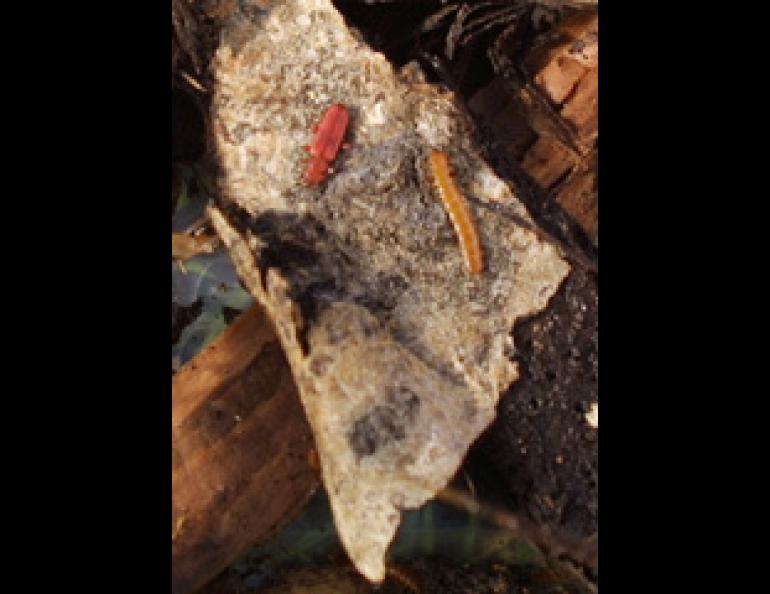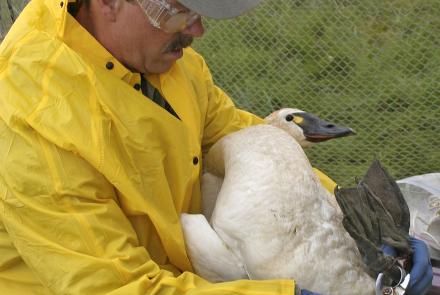
Insects ward off ice with antifreeze
As a breeze rustled yellow aspen leaves on Ester Dome, Jack Duman pried up rocks with his fingertips. Duman, an expert on the nifty adaptations insects have developed to survive winter, is the chairman of the Department of Biological Sciences at Notre Dame University. He was on Ester Dome in Fairbanks recently, searching for tiny beetles and other insects that will remain unfrozen this winter long after their surroundings have turned to ice. Duman and a University of Alaska scientist want to learn more about the substances that prevent insects from freezing by turning insect blood into antifreeze.
Duman was in Alaska along with researcher Valerie Bennett, also of Notre Dame. They joined Brian Barnes, a professor of zoophysiology at the University of Alaska Fairbanks, on a trip by Suburban to Toolik Lake, Wiseman, and a few other areas in northern Alaska. They stopped to collect insects along the way, then brought the bugs back to Barnes’ lab in Fairbanks.
Here, they began isolating the molecules in insect blood that prevent insects from becoming tiny ice cubes during the coldest Alaska winter days. While ethylene glycol keeps car radiators liquid at cold temperatures, insects use proteins within their blood as antifreeze. These proteins allow insects to remain in suspended animation until their bodies warm enough for them to crawl away in springtime. Antifreeze proteins within insect blood inhibit the growth of damaging ice crystals and stop recrystallization, the same process that turns old ice cream spiky and flattens its flavor.
Duman, Bennett and Barnes found Cucujus beetles under the bark of balsam poplar trees near Wiseman and in Fairbanks. Duman has studied the same species of beetle in Indiana. The Fighting Irish version of the Cucujus beetle perishes when temperatures drop to about -26 degrees C (-12 degrees Fahrenheit). Since the Alaska Cucujus beetle survives much colder winter temperatures, the researchers know insects must be doing something special here.
“We’re looking for proteins with a greater punch than we’ve seen before,” Duman said.
Alaska insects are the heavyweight champions of the insect world. In the 1970s, University of Alaska scientist Keith Miller found the larvae of gall wasps endured a temperature of -60 F to slither away the following spring.
Scientists in the past have identified two antifreeze proteins in Alaska insects, but the team of Duman, Bennett and Barnes expects to find many more. To find what proteins insects use as antifreeze, the researchers first draw a tiny amount of blood in a capillary tube. They freeze the blood with a spray can of compressed air, and place the sample in a cooling bath. Peering through a microscope, they watch the ice crystal until it melts, mark its temperature, then cool the bath of ethanol below zero degrees and mark the temperature at which a crystal within the blood refreezes. This exercise in the lab will help them to screen for the presence of specific proteins, some of which act as antibodies to ice.
During the three-year study, the scientists hope to find a protein they can apply to other useful areas. By introducing a gene for an antifreeze protein into a plant, Duman’s team was able to make the weed more frost-hardy by 1-3 degrees Celsius. A protein from Alaska insects might allow for even greater frost protection. Alaska insects may also carry proteins that someday will allow doctors to preserve human tissues and organs longer and with less damage than traditional methods. These a few of the potential gifts of the insects that live out their short lives on the forest floors, on trees, and under rocks all across Alaska.





